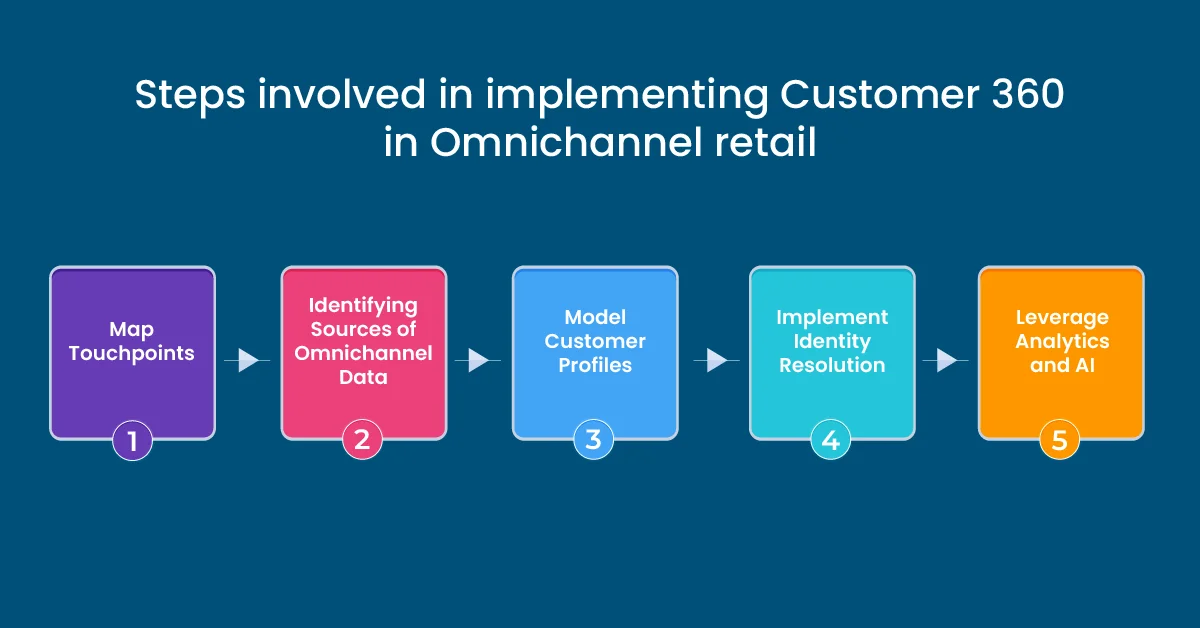Nowadays, businesses don’t just need to have an omnichannel presence but also need to be at the top of their game at every customer touchpoint. For this, marketers need to have a thorough understanding of their customers and the path they take while purchasing a product. This is where Customer 360 helps omnichannel retailers.
This Article Contains:
What is Customer 360?
Customer 360 is a strategic approach that involves integrating data from various sources and interactions to create a comprehensive and holistic understanding — or a 360-degree view — of every customer. This includes customer activities, interactions, demographic data, as well as relevant background information. Furthermore, it also includes their usage of the business's platform, past purchases, social network activity, and contact details.
Organizations can leverage all this data and create a comprehensive customer profile that can help them gain deeper insights into their customers and offer tailored experiences accordingly. Customer 360 is also crucial for enhancing customer engagement, optimizing marketing efforts, identifying chances for upselling and cross-selling, and strengthening customer relationships.
It also serves as a single, consolidated source of reliable customer data, removing obstacles to data access and guaranteeing that every team has access to consistent and accurate customer information.
What is Customer 360 view?
A customer 360 view provides a comprehensive and cohesive view of a customer. Because of the wealth of information they cover, the customer 360 view becomes a strategic tool that enables firms to provide the best possible customer experiences across unified channels and touchpoints through tailored integration. The key components of a customer 360 view are as follows:
1. Customer demographics
It includes past and present purchasing history, basic contact information, information about interactions amongst different business touchpoints, sociodemographic attributes, and actions within the society including insolvency records and social media activity.
2. Product-related activities
It includes store information i.e. customer’s customer-preferred store and how frequently the customer purchases, their purchase triggers, purchase trends they follow, and purchase product history.
3. Customer Interaction history
It includes recent product/service activity, customer communication via all channels, product views and reviews, outreach campaign activity, interactions through customer service departments, and the entire sales process history.
4. Marketing Intelligence
It includes predictions based on AI algorithms, lifetime sales, projected lifetime value, average transaction value, marketing campaign effectiveness, and changes in consumer behavior.
How can Customer 360 help in Omnichannel Retail?
A customer 360 view in omnichannel retail enables companies to fully understand the preferences, needs, and behaviors of their customers on a variety of platforms, including social media, mobile applications, online stores as well as physical stores. By analyzing customer data from many sources, companies are able to identify trends, customize interactions, and build long-lasting connections with their customers.
Retailers can improve customer engagement, which can lead to improved interactions, more successful marketing campaigns, the discovery of new upselling and cross-selling opportunities, and the improvement of customer strategies for better optimization and can also gain a competitive advantage and deliver high-quality customer service.
How to Implement Customer 360 in Omnichannel Retail?
Implementing a Customer 360 in Omnichannel retail involves various steps:

1. Map Touchpoints
Mapping touchpoints involves identifying every point of contact with the customer at every stage of their journey. This helps retailers to strengthen every interaction and gain a better understanding of how customers engage with their brand. Mapping touchpoints also helps retailers identify potential problems, entry barriers or discrepancies that customers may face at each interaction point.
2. Identifying Sources of Omnichannel Data
This involves identifying every data source contributing to the customer 360, including websites, ad networks, mobile apps, social media platforms, software tools, and SaaS apps utilized by retailers for sales and marketing. Retailers can also identify sources of omnichannel data by looking at third-party data sources such as Amazon, food delivery services, distributor data, e-commerce, and data syndicators.
3. Model Customer Profiles
Modeling customer profiles helps retailers in recognizing patterns and trends in customer behavior, which can guide marketing and sales approaches. Retailers can also customize marketing campaigns and provide individual customers with individualized recommendations by creating thorough customer profiles which leads to increased customer engagement, and increased loyalty to ultimately drive sales.
4. Implement Identity Resolution
Identity resolution links user behaviors and attributes from several interactions and channels to create a single customer profile. This can enhance customer experiences, enable personalized interactions, and allow targeted marketing campaigns by accurately identifying users and consolidating their data trails.
Implementing Identity Resolution helps businesses create a unified picture of the customer by linking their interactions across various points of contact.
5. Leverage Analytics and AI
AI algorithms offer predictive analytics by spotting trends, patterns, and correlations that help retailers understand consumer behavior and preferences. This makes it easier for them to create highly targeted offers and communications for every customer.
AI and machine learning also facilitate the development of tailored customer experiences using chatbots. It also provides real-time data which helps retailers quickly respond to the requirements and preferences ensuring the Customer 360 view's ongoing relevance and value.
Challenges in Implementing Customer 360 in Omnichannel Retail
While Customer 360 offers numerous advantages, it also presents several challenges, such as:
1. Siloed Data
Omnichannel data is dispersed across various websites, devices, ad platforms, and social media platforms, creating challenges in establishing a consistent storage facility, or "single source of truth”, to centralize this data.
Due to this, it becomes difficult to obtain a complete understanding of customer data resulting in inconsistencies and quality concerns from duplicated data. Without a central data repository, analyzing, and extracting valuable insights becomes challenging, affecting the development of a thorough Customer 360 view.
To overcome this challenge, retailers should implement a robust data integration platform to unify data sources into a centralized repository. They also need to utilize data governance practices to ensure quality and consistency. Employing analytics tools for comprehensive customer insights can facilitate a holistic Customer 360 view and informed decision-making.
2. Privacy Regulations
One of the biggest challenges in implementing Customer 360 in omnichannel retail is privacy regulations. To track customer activities across channels, retailers need to collect and evaluate consumer data from a variety of sources.
Privacy regulations like GDPR and CCPA require businesses to obtain customer consent before collecting and utilizing their data. Customers are also increasingly concerned about their data privacy, hence retailers should strike a balance between personalisation with data privacy and have strong security measures in place.
To comply with privacy regulations, retailers must obtain customer consent before collecting and utilizing their data. They should also implement strong security measures to safeguard customer data. Moreover, retailers must strike a balance between personalization efforts and respect for data privacy concerns.
By implementing transparent data practices, they can build trust with customers and enable successful Customer 360 implementation.
3. Inventory Management
This could be another big challenge when it comes to implementing customer 360 in omnichannel retail. Firstly, inventory data silos prevent retailers from getting a comprehensive detail of their stock.
When retailers do not monitor inventory across all channels, it reduces visibility, resulting in inefficient resource usage and missed sales opportunities. Additionally, handling exchanges and returns across various channels also adds complexity, affecting customer retention and loyalty.
Overcoming inventory challenges in Customer 360 implementation involves integrating inventory data across channels. By monitoring inventory comprehensively, retailers can enhance visibility, optimize resource usage, and seize sales opportunities. Moreover, streamlining the exchange and return processes across channels improves customer retention and loyalty.
4. Variety of Data
One of the most common problems in omnichannel e-commerce is data being spread out across different channels and platforms, and are present in a variety of formats. As a result of this, omnichannel retailers find it hard to compile data from different channels to create a single source of truth. Moreover, analyzing a combination of quantitative and qualitative data also becomes challenging.
Retailers should adopt a robust data integration platform that supports real-time data synchronization across all channels. This platform should have built-in connectors to seamlessly gather data from diverse sources, such as websites, mobile apps, social media platforms, and third-party marketplaces.
Additionally, employing data standardization techniques is crucial. By standardizing data formats and schemas, retailers can ensure consistency and compatibility across different sources and formats. This facilitates easier aggregation and analysis of data.
Conclusion
Establishing customer 360 in omnichannel retail is crucial for providing buyers with a streamlined and customized experience across all channels. While building a customer 360 may involve some time and cost commitment in the initial stages, the benefits of building and using customer 360 far outweigh the costs in the long run.
Retailers can leverage advanced technologies and partner with omnichannel ecommerce implementation experts to navigate these challenges and use the customer 360 methodology to drive growth and success in the competitive marketplace to its full potential.
Frequently Asked Questions
1. Who uses customer 360?
Omnichannel retailers looking to provide a seamless and personalized experience to their customers use a customer 360.
2. How much does customer 360 cost?
The cost of building a customer 360 depends on many factors, such as the industry, digital presence, and business objectives.
3. What are the benefits of customer 360?
A customer 360 view enables retailers to fully understand the preferences, needs, and behaviors of their customers to help them personalize customer interactions.






